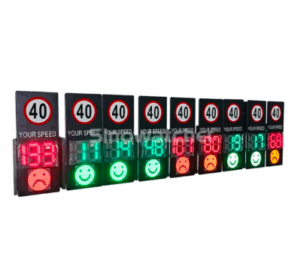Home » Radar Speed Signs vs. Traditional Speed Limits

Traditional speed limits, displayed on static signs, have been the standard for decades. While they establish clear rules, their effectiveness often depends on drivers’ willingness to notice and comply.
In recent years, radar speed signs have become a popular alternative or complement to these static signs, offering real-time feedback that changes driver behavior more effectively. Comparing radar speed signs to traditional speed limits highlights important differences in awareness, adaptability, and impact on communities.

Traditional speed limits rely on drivers noticing the posted number and consciously adjusting their behavior. On familiar roads, many drivers simply overlook these signs. Their static nature means they quickly blend into the environment, especially in areas filled with other signage.
In contrast, radar speed signs use technology to actively engage drivers. By displaying the actual speed of approaching vehicles, they make the posted limit personal and harder to ignore.
The flashing digits or color changes grab attention immediately, creating a stronger connection between behavior and responsibility. This difference in visibility is one of the main reasons radar speed signs are seen as more effective in areas where speeding is common.
Static speed limits depend heavily on external enforcement. Police patrols and traffic tickets are often required to ensure compliance, which can strain resources and sometimes create tension between drivers and law enforcement.
This behavioral nudge is particularly effective in school zones, residential neighborhoods, and construction areas where safety is critical. Unlike static signs, radar speed signs engage directly with drivers, reducing reliance on punitive enforcement.
Traditional speed limits are fixed and uniform. While this provides consistency, it also limits flexibility. A posted sign at 30 mph looks the same whether traffic is light, heavy, or unusually fast.This can create mismatches between road conditions and driver expectations.
Radar speed signs adapt better to changing environments.They can be placed temporarily in high-risk zones, such as during roadwork or near schools during arrival and dismissal times.
Many are solar-powered and portable, making relocation easy. This adaptability allows communities to target problem areas more effectively, without permanently altering speed limits.
One criticism of traditional speed limits is that they lose impact over time, especially on routes drivers use daily. Commuters often ignore signs they see repeatedly, and without enforcement, the rules may not influence behavior consistently.
Radar speed signs create longer-lasting impressions because they provide active reminders. Even if a driver initially slows only while passing the sign, the repeated feedback helps reinforce safer habits over time.
Communities that use radar speed signs regularly report measurable reductions in average vehicle speeds, which shows their sustained effectiveness compared to static signs alone.
Enforcement of traditional speed limits often involves issuing fines, which can create negative perceptions. Drivers may view speed traps as revenue-generating tools rather than safety measures, leading to mistrust of local authorities.
In comparison, radar speed signs are generally perceived as fair and helpful. They do not issue tickets or impose penalties; they simply remind drivers to slow down.
Implementing traditional speed limits is inexpensive at first, requiring only static signs. However, ongoing enforcement requires significant investment in police time, equipment, and court processes.
Over the long term, this enforcement can be costly.Radar speed signs have higher upfront costs, but their low maintenance and independence reduce the need for constant enforcement. Solar-powered options lower operating expenses further.
By providing continuous, automated reminders, radar speed signs allow law enforcement to focus resources on other priorities. Communities often find that the investment pays off in both safety and efficiency.
Traditional speed limits provide no feedback beyond the rule itself. Authorities may only learn about problems through complaints, accidents, or costly traffic studies.
Modern radar speed signs can collect valuable data on vehicle speeds, traffic volumes, and peak travel times. This information helps cities and towns make better decisions about where to place permanent traffic calming measures or how to adjust speed limits.
Data-driven insights improve planning and allow communities to address issues proactively, rather than reacting to accidents after they occur.
Comparing radar speed signs with traditional speed limits reveals clear advantages for communities seeking safer roads.Traditional speed limits set the rules, but without enforcement, their influence is limited.
Radar speed signs, by contrast, offer immediate feedback, adapt to changing needs, and build trust with drivers through non-punitive reminders. They also provide valuable traffic data and reduce reliance on enforcement resources.
